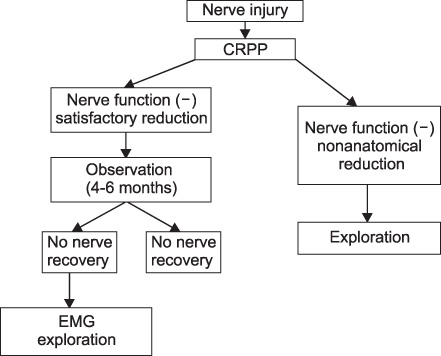J Korean Orthop Assoc.
2008 Apr;43(2):240-246. 10.4055/jkoa.2008.43.2.240.
Neuro-vascular Injuries Associated with Supracondylar Fractures of the Humerus in Children
- Affiliations
-
- 1Department of Orthopedic Surgery, Medical School, Research Institute of Clinical Medicine, Chonbuk National University, Jeonju, Korea. jrkeem@chonbuk.ac.kr
- KMID: 2106446
- DOI: http://doi.org/10.4055/jkoa.2008.43.2.240
Abstract
-
PURPOSE: Supracondylar fractures in children have the potential for associated neuro-vascular injuries. It is important to diagnose and manage these fractures because they are often underestimated when assessing a painful elbow in agitated children. This study focused on evaluating the frequency of neuro-vascular injuries associated with fracture displacement, and to define a therapeutic strategy.
MATERIALS AND METHODS
From January 1997 to December 2006, 128 children who were available to follow up were examined restrospectively. The incidence of neuro-vascular injuries was investigated, and the types and displacement of fractures were classified. The therapeutic strategy and complications were also defined.
RESULTS
Neuro-vascular complications occurred in 24 patients. Seventeen, 12, 4, 4 and 1 patient had only neural injuries, radial, ulnar, median, and anterior interosseous nerve. There were 4 patients with both neural and vascular injuries, and 3 patients had only vascular injuries. Most neural injured patients had recovered completely, but 1 patient had not recovered after 6 months. Therefore, exploration and sural nerve graft was performed.
CONCLUSION
The frequency of neuro-vascular injury is a result of severely displaced supracondylar fracture. A therapeutic strategy for supracondylar fractures in children is proposed to minimize complications.
MeSH Terms
Figure
Reference
-
1. Campbell CC, Waters PM, Emans JB, Kasser JR, Millis MB. Neurovascular injury and displacement in type III supracondylar humerus fractures. J Pediatr Orthop. 1995. 15:47–52.
Article2. Cheng JC, Lam TP, Shen WY. Closed reduction and percutaneous pinning for type III displaced supracondylar fractures of the humerus in children. J Orthop Trauma. 1995. 9:511–515.
Article3. Copley LA, Dormans JP, Davidson RS. Vascular injuries and their sequelae in pediatric supracondylar humeral fractures: toward a goal of prevention. J Pediatr Orthop. 1996. 16:99–103.
Article4. Culp RW, Osterman AL, Davidson RS, Skirven T, Bora FW Jr. Neural injuries associated with supracondylar fractures of the humerus in children. J Bone Joint Surg Am. 1990. 72:1211–1215.
Article5. Louahem DM, Nebunescu A, Canavese F, Dimeglio A. Neurovascular complications and severe displacement in supracondylar humerus fractures in children: defensive or offensive strategy? J Pediatr Ortho B. 2006. 15:51–57.
Article6. Flynn JC, Matthews JG, Benoit RL. Blind pinning of displaced of the elbow in children. J Bone Joint Surg Am. 1974. 56:263–272.7. Fowles JV, Kassab MT. Displaced supracondylar fractures of the elbow in children. J Bone Joint Surg Br. 1974. 56:490–500.
Article8. Garbuz DS, Leitch K, Wright JG. The treatment of supracondylar fractures in children with an absent radial pulse. J Pediatr Orthop. 1996. 16:594–596.
Article9. Gosens T, Bongers KJ. Neurovascular complications and functional outcome in displaced supracondylar fractures of the humerus in children. Injury. 2003. 34:267–273.
Article10. Jones ET, Louis DS. Median nerve injuries associated with supracondylar fractures of the humerus in children. Clin Orthop Relat Res. 1980. 150:181–186.
Article11. Kamal AS, Austin RT. Dislocation of the median nerve and brachial artery in supracondylar fractures of the humerus. Injury. 1981. 12:161–164.
Article12. Lipscomb PR. Vascular and neural complications in supracondylar fractures of the humerus in children. J Bone Joint Surg Am. 1995. 37:487–492.
Article13. McGraw JJ, Akbarnia BA, Hanel DP, Keppler L, Burdge RE. Neurological complications resulting from supracondylar fractures of the humerus in children. J Pediatr Orthop. 1986. 6:647–650.
Article14. Rasool MN. Ulnar nerve injury after K-wire fixation of supracondylar humerus fractures in children. J Ped Orthop. 1998. 18:686–690.
Article15. Rasool MN, Naidoo KS. Supracondylar fractures: posterolateral type with brachialis muscle penetration and neurovascular injury. J Pediatr Orthop. 1999. 19:518–522.
Article16. Ray SA, Ivory JP, Beavis JP. Use of pulse oximetry during manipulation of supracondylar fractures of the humerus. Injury. 1991. 22:103–104.
Article17. Shaw BA, Kasser JR, Emans JB, Rand FF. Management of vascular injuries in displaced supracondylar humerus fractures without arteriography. J Orthop Trauma. 1990. 4:25–29.
Article18. Shim JS, Lee YS. Treatment of completely displaced supracondylar fracture of the humerus in children by cross-fixation with three kirschner wires. J Pediatr Orthop. 2002. 22:12–16.
Article19. Spinner M, Schreiber SN. Anterior interosseous nerve paralysis as a complication of supracondylar fractures of the humerus in children. J Bone Joint Surg Am. 1969. 51:1584–1590.20. Wenger DR, Pring ME. Rang's children's fractures. 2005. 3rd ed. Phildelphia: J.B. Lippincott Co;95–118.21. Wilkins KE. The operative management of supracondylar fractures. Orthop Clin N Am. 1990. 21:269–289.
Article
- Full Text Links
- Actions
-
Cited
- CITED
-
- Close
- Share
- Similar articles
-
- A Clinical Study of Supracondylar Fracture of the Humerus in Children
- Flexion-type Humerus Supracondylar Fractures in Children
- Clinical Studies on the Supracondylar Fractures of the Humerus in Chilldren
- Clinical Observation of Supracondylar fracture of Humerus in Children
- Neurovascular injuries in supracondylar fractures of the humerus in children




